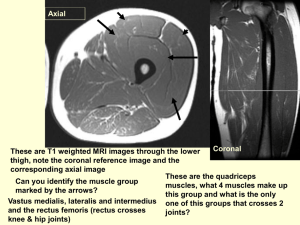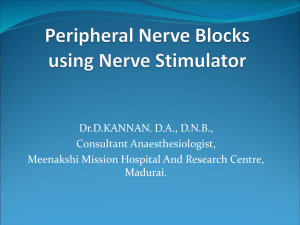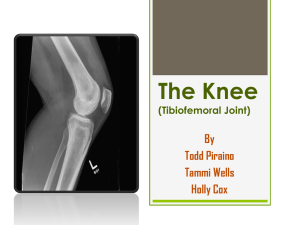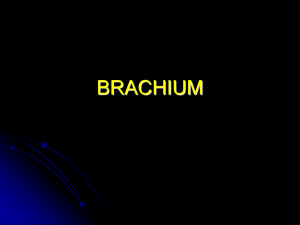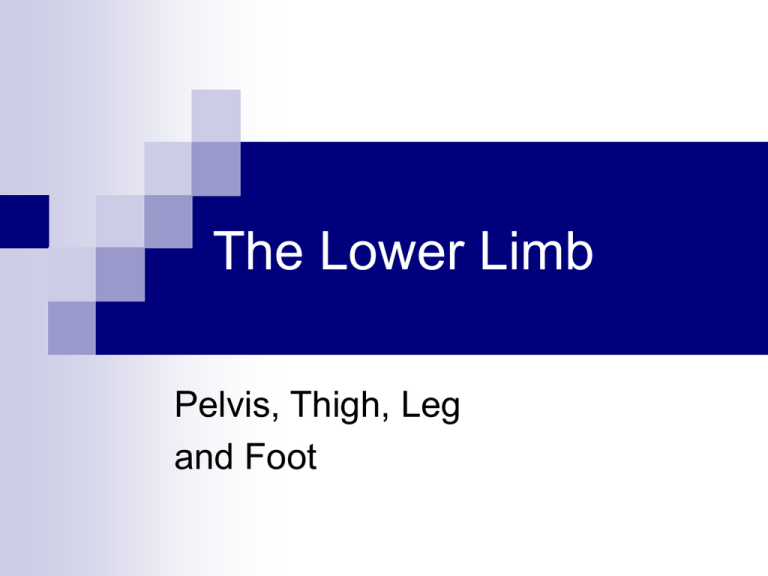
The Lower Limb
Pelvis, Thigh, Leg
and Foot
Innervation
Plexuses of the Lower Limb
“Lumbosacral plexus”
Lumbar Plexus
Arises from L1-L4
Lies within the psoas major
muscle
Mostly anterior structures
Sacral Plexus
Arises from spinal nerve
L4-S4
Lies caudal to the lumbar
plexus
Mostly posterior structures
Diaphragm and posterior abdominal wall:
The psoas major and minor muscles, the quadratus lumborum
muscle. The lumbar plexus and its related nerves.
Lumbosacral plexus
Lumbar plexus (T12- L4):
1- Obturator nerve (L2-L3-L4)
2- Femoral nerve (L2-L3-L4)
3- Lumbosacral trunk (L4-L5)
7- subcostal nerve (T12)
8- iliohypogastric N. (T12-L1)
9- ilioinguinal N. (L1)
10- genitofamoral N. (L1-L2)
11- lateral cutaneous N. of the thigh (L2-L3)
Lumbar Plexus
Femoral nerve
Cutaneous branches
Motor branches
Sensory
Skin medial thigh; hip, knee joints
Motor
Adductor muscles
Lateral femoral cutaneous
Sensory
Anterior thigh muscles (e.g. quadriceps,
sartorius, iliopsoas)
Obturator nerve
Thigh, leg, foot (e.g. saphenous nerve)
Skin lateral thigh
Genitofemoral
Sensory
Skin scrotum, labia major, anterior thigh
Motor
Cremaster muscle
Lumbosacral plexus
Sacral plexus:
Sciatic nerve (roots):
L4
L5
S1
S2
S3
*Sciatic nerve is the thickest nerve of body.
*It is composed of Common Peroneal and
Tibial nerves.
*Com. Peroneal: composed of dorsal rami
Tibial: composed of ventral rami
*L4+L5= Lumbosacral trunk
3- Lumbosacral trunk
4- Sciatic nerve
5- common peroneal N.
6- tibial N.
12- posterior femoral cutaneous nerve
13- pudendal nerve
14- superior gluteal nerve
Sacral Plexus
Sciatic
Motor:
Hamstring
Branches into:
Tibial nerve
Common fibular (peroneal) nerve
Cutaneous
Posterior leg and sole of foot
Motor
Posterior leg, foot
Cutaneous
Anterior and lateral leg, dorsum foot
Motor
Lateral compartment, tibialis anterior,
toe extensors
Superior gluteal nerve
Motor
Gluteus medius and minimus, tensor
fasciae latae
Sacral Plexus (continued)
Inferior gluteal nerve
Motor
Gluteus maximus
Posterior femoral
cutaneous nerve
Sensory
Inferior buttocks, posterior
thigh, popliteal fossa
Pudendal nerve
Sensory
External genitalia, anus
Motor
Muscles of perineum
Vasculature
Arteries
Common iliac (from
aorta) branches into:
Internal
iliac
Supplies pelvic organs
External
iliac
Supplies lower limb
Arteries
Internal iliac branches into:
Cranial
and Caudal Gluteals
(Superior and Inferior)
Gluteals
Internal Pudendal
Perineum, external genitalia
Obturator
Adductor muscles
Other
branches supply rectum,
bladder, uterus, vagina, male
reproductive glands
Arteries
External iliac becomes…….
Femoral
Once passes the inguinal ligament
Lower limb
Branches into Deep femoral
Adductors, hamstrings, quadriceps
Branches into Medial/lateral femoral
circumflex
Head and neck of femur
Femoral becomes……
Popliteal (continuation of femoral)
Branches into:
Geniculars
Knee
Splits into:
Anterior Tibial
Anterior leg muscles, further branches to
feet
Posterior Tibial
Flexor muscles, plantar arch, branches to
Veins
Deep Veins: Mostly share names of
arteries
Ultimately empty into Inferior Vena
Cava
Plantar
Tibial
Fibular
Popliteal
Femoral
External/internal iliac
Common iliac
Superficial Veins
Dorsal venous arch (foot)
Great saphenous (empties into femoral)
Small saphenous (empties into
popliteal)
Lower limb:
Muscles, Nerves and Vessels
Arteries to the pelvis
The internal iliac artery and it’s branches
Arteries of the pelvis and the thigh
5- abdominal aorta
4- common iliac artery
1- internal iliac artery
15- external iliac artery
19- femoral artery
24- deep femoral artery
25- medial circumflex femoral artery
27- lateral circumflex femoral artery
30- terminal branches of deep femoral
artery, the perforating arteries.
33- descending genicular artery
Arteries of the leg
4-5: lateral and medial superior genicular aa.
6-7:lateral and medial inferior genicular aa.
8- medial (middle) genicular artery (piercing
the oblique popliteal ligament to reach
inside the knee joint).
1- Anterior tibial artery
2- posterior tibial artery
20- fibular artery
12- Dorsalis pedis artery
Arteries of the foot
*When the Anterior tibial artery (1) passes
Beneath the superior extensor retinaculum,
It is called dorsal artery of the foot or
Dorsalis Pedis artery (11).
12- shows where its pulsation can be felt.
Ant. Tibial artery or Dorsalis pedis may give
The lateral tarsal artery (13).
Together, the lateral tarsal and dorsalis pedis
Make the arcuate artery (14) giving rise to
Metatarsal (15) and dorsal digital (16) arteries.
*Dorsalis pedis gives a deep branch to join
The plantar arch.
Arteries of the foot
Posterior tibial artery(2) in the plantar region
gives the medial (21) and lateral (23)
Plantar arteries.
Lateral plantar artery makes most part of the
plantar arch (22) which give rise to plantar
metatarsal arteries (24) and proper plantar
digital arteries (25).
The dorsal and plantar arches are connected
via perforating branches.
Pulsation of dorsalis pedis artery may be lost
in some peripharal vascular diseases such as
Burger’s disease or also in diabetes mellitus.
Occlusion of blood vessels lead to gangrene.
And even autoamputation of the first toe.
Scars on the skin may develop.
Femoral hernia:
Subinguinal region
9- external pudendal vessels
10- superficial epigastric vessels
11- superficial circumflex iliac vessels
Anterior thigh region (deep)
The femoral triangle
Borders: Sartorius laterally
Adductor longus, medially and also the floor
Ilioinguinal ligament superiorly.
Floor: iliopsoas m., pectineus m., and
adductor longus.
Content:
A- lateral femoral cutaneous nerve
B- Femoral nerve
C- Structures inside the femoral sheath
*Content of Femoral Ring:
Femoral artery and genitofemoral N. (fem)
Femoral vein
Lymph nodes and areolar tissue (femoral
Canal), the Rosenmuller node (they drain the
Glans penis and clitoris)
*Femoral hernia: painful, more in female,
below and lateral to pubic tubercle.
Anterior thigh region (deep)
Subsartorius (adductor, Hunter’s) canal:
*Starts distal to femoral triangle.
Content:
Femoral artery and vein, saphenous nerve,
nerve to Vastus medialis, small branches of
Obturator nerve and great saphenous
vein
Deep gluteal region:
Greater sciatic foramen
is divided by Piriformis muscle (2).
Suprapiriformis hiatus:
sup. Gluteal vessels (3, 4, 5)
Infrapiriformis hiatus:
Inferior Gluteal vessels (8,9)
Internal pudendal artery and vein (10)
Pudendal nerve (11)
Posterior Cutaneous N. of the thigh (14)
Sciatic nerve (15)
Nerve to obturator internus (not shown)
[18- inf. Clunial N., and 19- perineal N. are
branches of posterior cutaneous N. of the thigh.]
Int. pudendal artery, pudendal nerve and nerve to
Obturator int. reenter the pelvis through lesser
Sciatic foramen.
Lesser Sciatic Foramen:
Int. pudendal vessels. Pudendal nerve. Nerve to
Obturator int. and tendon of Obturator internus.
Posterior femoral region
Division of sciatic nerve
Perforating vessels (artery and vein)
Popliteal region (superficial)
1- Greater saphenous vein (medially)
2- Saphenous nerve (medially)
3- Small saphenous vein
4- Medial sural cutaneous nerve
5- Branches of post. femoral cutaneous N.
Popliteal fossa:
Diamond shape.
Walls:
Inferiorly:
Gastrocnemius (medial and lateral heads) M.
Superiorly:
Semitendinosus and semimembranosus (medial)
Biceps femoris (lateral)
Its floor is composed of:
Popliteal surface of femur, knee joint and upper
Tibial bone, oblique popliteal ligament and
Popliteal muscle with its covering fascia.
Content of popliteal fossa:
Popliteal artery
Popliteal vein
Tibial N.
Common peroneal N.
Genicular arteries and veins
Posterior region of the leg
1- triceps surae m.
2- gastrocnemius
3- soleus
4- calcaneal tendon
5- saphenous nerve
6- great saphenous vein
7- small saphenous vein
9- medial sural nerve
10- communicating branch (lateral sural N.)
11- sural nerve
12- lateral dorsal cutaneous nerve
15- common peroneal nerve
16- posterior tibial artery
17- peroneal (fibular artery
18- popliteal artery
19- anterior tibial artery
20- perforating branch of fibular artery
Medial retromalleolar region:
1-2, the Flexor retinaculum
3- greater saphenous vein
5- saphenous nerve
Structures passing beneath the
Flexor retinaculum
(from medial to lateral):
Tibialis posterior tendon (7)
Flexor digitorum longus (8)
Posterior tibial artery and veins (10, 11)
Tibial nerve (12)
Flexor Hallucis longus (9)
Muscles of the dorsum of the foot:
Tendon of the long extensors of the foot, lie
superficial to these muscles and they form a
dorsal aponeurosis into which the short
Extensors of the digits, plantar and dorsal
Interosseous muscles radiate.
Extensor digitorum brevis (6):
Origin: Calcaneus (7)
Insertion: with 3 tendons to dorsal
aponeurosis (8).
Function: dorsiflexion of these digits
Innervation: Deep peroneal nerve (S1-S2).
Extensor Hallucis brevis (9):
Origin: Calcaneus
Insertion: Dorsal aponeurosis of 1st digit
Function: Dorsiflexion of 1st digit
Innervation: Deep peroneal nerve (S1-S2).
10- tibialis anterior tendon
11- Peroneus tertius
Muscles of the sole of the foot:
1- Plantar Aponeurosis
Consist of longitudinal and transverse fibers.
It maintains the longitudinal arch of the foot
and protects the vessels and nerves there.
5- Abductor Hallucis:
Origin: Tuber Calcanei (6), plantar aponeurosis (7).
Insertion: medial sesomoid bone (8) and base
of proximal phalanx of 1st toe (9).
Innervation: Medial plantar Nerve (L5-S1).
10- Fexor Hallucis Brevis:
Origin: medial cuneiform bone (11)
It has 2 heads. A medial head (12) which
extends to medial sesamoid bone (13) and
Its lateral head (15) extend to lateral sesamoid
bone (16) and inserted on proximal phalanx
of 1st toe.
Innervation: Medial Plantar Nerve (L5-S1).
Muscles of the sole of the foot:
11- Flexor digitorum Brevis:
Origin: tuber calcanei
Insertion: middle phalax of 2nd-4th digits
Innervation: Medial Plantar N (L5-S1).
1- Lumbriclas (4 ones)
Tiny muscles originating from tendon (2)
of the flexor digitorum longus (medial side).
Insertion: Dorsal aponeurosis of 2nd-5th digit.
Function: plantar flexion of these digits
Innervation: Medial Plantar N to 1, and
Lat Plantar N to 2, 3 and 4 (S2 and S3)
3- Quadratus Plantae:
Origin: by 2 heads from calcaneus
Insertion: lateral border of the tendon of the
Flexor digitorum longus.
Innervation: Lateral Plantar N. (S1-S2).
Muscles of the sole of the foot:
Plantar interossei MM (3), Blue
They have single head, Number 7
Originate from medial side of 3rd-5th
metatarsals bones.
Insertion: medial side of 3rd-5th digits.
Function: Adductors of the digits
Innervation: Lateral Plantar N (S2-S3).
Dorsal interossei MM (4), Red
They have 2 heads Number 9
Originate from opposing surface of all
metatarsals
Insertion: to base of 2nd-4th digits
Function: Abductors of the digits
Innervation: Lateral Plantar N (S2-S3).
Muscles of the sole of the foot:
1- Adductor Hallucis:
Has 2 heads:
oblique head (3) and the transverse head (9).
Innervation: Lateral Plantar N (S1-S2)
7- Long Plantar Ligament
12-Opponens digiti minimi,
Innervation: Lat Plantar N (S1-S2)
15-16: Flexor Digiti Minimi:
Innervation: Lateral Plantar N (S1-S2)
18- Abductor Digiti Minimi
Origin: calcaneus(20) and 5th metatarsal (21)
Insertion: Base of proximal phalanx of the
5th digit (22).
Innervation: Lateral Plantar N (S1-S2).
23- Quadratus Plantae
Plantar region superficial:
Plantar aponeurosis (1)
Plantar region deep:
Lateral plantar nerve (13) and
Medial plantar nerve (4), innervate the
muscles and skin of the plantar side.
Plantar arteries and veins (15,16, 3, 4)
are involved in blood supply and venous
drainage of the plantar region of the foot.


